There are many ways to increase tomato productivity, and one of them is bag growing. This method has many advantages, including protecting plants from pests. But not all varieties are suitable for its use. It is important to observe the terms of work, the basic rules of agricultural technology.
Content
The advantages of the method
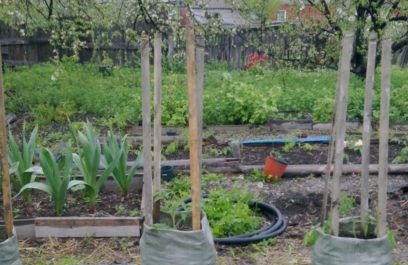 Growing tomatoes in bags is an unusual option, but experienced gardeners are convinced that this is a convenient and less expensive way
Growing tomatoes in bags is an unusual option, but experienced gardeners are convinced that this is a convenient and less expensive way
Benefits:
- installation of bags anywhere, depending on convenience;
- easy to shelter from temperature changes and weather conditions;
- moisture evaporates more slowly, and therefore less watering is required;
- the soil heats up faster and cools down more slowly, the crop matures faster;
- nutrients and water go directly to the roots;
- minimal risk of infection of the roots and shrubs with diseases and insect attacks;
- simplified plant care.
Suitable varieties
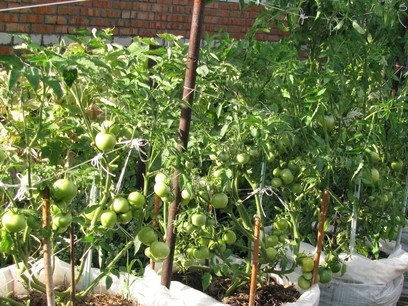 Not all types of tomatoes are suitable for growing in bags, especially exotic species. Mostly used:
Not all types of tomatoes are suitable for growing in bags, especially exotic species. Mostly used:
- Determinant varieties are species that have a growth limit and stop growing after tying 4-8 brushes. Such bushes bear fruit once a season and are often stunted.
- Hybrids - are characterized by strong growth and unpretentious care.
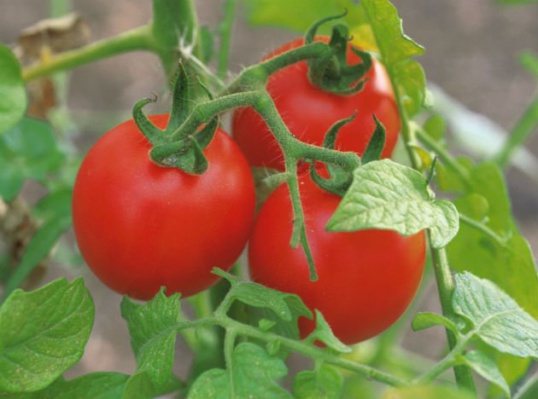 You may be interested in:
You may be interested in:Most often, gardeners grow such varieties as:
- Bourgeois - easily adapts to conditions, gives large fruits of a rounded shape, weighing 300-400 g.
- Spring of the North is a medium-early variety of large sizes in 210-350 g, rounded with a matte pink-red color.
- Openwork - a hybrid mid-early variety, resistant to any conditions and giving a good harvest weighing 240-260 g.
These species bear fruit well in bags and reach large sizes.
Using the method in a greenhouse and in open ground
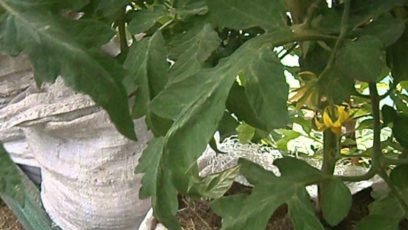 The method of growing in bags is suitable for open ground and in greenhouses. In the open ground, the same manipulations are carried out as with conventional planting in bags. Watering is carried out regularly, but not plentifully, as the water does not evaporate well, because of which the roots can rot. In the first 25 days, new roots can grow, which should be covered with a new portion of the earth.
The method of growing in bags is suitable for open ground and in greenhouses. In the open ground, the same manipulations are carried out as with conventional planting in bags. Watering is carried out regularly, but not plentifully, as the water does not evaporate well, because of which the roots can rot. In the first 25 days, new roots can grow, which should be covered with a new portion of the earth.
Before transferring the seedlings to the greenhouse, the wells must first be filled with a weak solution of potassium permanganate (1%). After absorbing the solution into the soil, you can place the sprouts in bags and cover with earth. At the same time, water the tomatoes only after 14 days. To save energy and nutrients in the bushes, stepsons are removed before they reach 50 mm.
As with ordinary greenhouse cultivation, it is necessary to carry out the pollination procedure - in the morning in sunny weather, gently brush the plant brushes with a rag. Then the leaves are watered and sprayed with clean water. After 2 hours, the greenhouse is opened for ventilation.
In greenhouses, there is often infection with late blight - a fungus of leaves or fruits. To avoid the disease, you can periodically spray with potassium-containing solutions.
If the bushes have not been watered for a long time, then immediately they should not be abundantly irrigated.It is better to moisten the topsoil first, and after a few hours, pour plenty of water.
What you need for landing
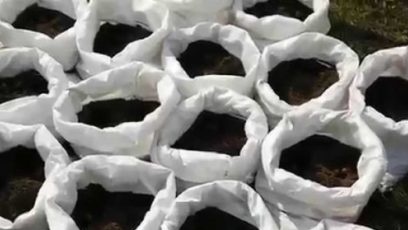 Before starting the cultivation of tomatoes in bags, you need to prepare all the necessary materials:
Before starting the cultivation of tomatoes in bags, you need to prepare all the necessary materials:
- bags;
- priming;
- supports.
An important step is the eruption of small drainage holes on the sides of the bags, necessary so that excess moisture does not stagnate.
As soil, you can use ordinary earth from the garden, fertilized with useful substances:
- humus;
- wood ash (1 liter per 20 liters of soil);
- superphosphate (20 g per 20 l of soil);
- sawdust for friability.
As supports, pegs are needed, to which the bushes are tied with a rope or wire.
Bags are better to choose large from 30 to 50 kg of burlap (polypropylene). They most often pack sugar. They are strong, they pass air and moisture well. It is better to use white bags, since light colors reflect light rays, and the plant does not overheat, and the roots do not deteriorate.
Many experienced gardeners advise to disinfect bags in potassium permanganate solution before planting. After the bags, you can use it for 2-3 years, and change the soil every year.
Soil preparation
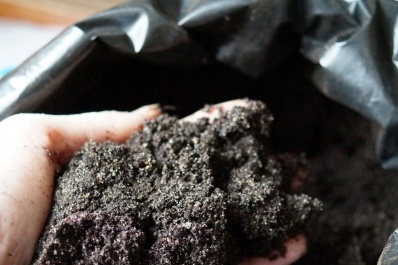 Prepare the soil for planting tomatoes should be in the fall, especially if it is mixed with ash. If ash is added before planting, the roots of the plant may get burned. And by spring it will be neutralized, but important minerals for growth will remain, and the soil will be suitable for the new season.
Prepare the soil for planting tomatoes should be in the fall, especially if it is mixed with ash. If ash is added before planting, the roots of the plant may get burned. And by spring it will be neutralized, but important minerals for growth will remain, and the soil will be suitable for the new season.
If the soil is not prepared in advance, then instead of ash, seedlings are watered with an extract from the ash (1 cup is insisted in 10 liters of water for a day, stirring occasionally) and filtered through a layer of gauze.
To disinfect the earth from diseases and pests, it is steamed in a water bath under a lid for one to two hours, and let it cool. Store the treated soil in crates or in bags on the street so that harmful bacteria and the remaining insect larvae perish in the cold.
Before placing seedlings in the ground, it is necessary to further disinfect it from pests - the soil is treated with a hot solution of copper sulfate a week before the planned planting. Then fertilize and mix again.
After planting, you can mulch the top layer with humus. This layer will additionally protect the root system from overheating, drying out and crusting, which usually requires continuous loosening.
The principle of planting tomatoes
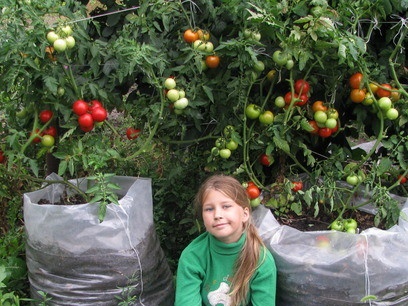 Tomatoes are planted mainly in the form of seedlings. For its sowing, use the finished mixture or prepared independently, mixing several useful substances:
Tomatoes are planted mainly in the form of seedlings. For its sowing, use the finished mixture or prepared independently, mixing several useful substances:
- part of peat;
- humus or compost;
- turf or leaf land;
- part of river sand.
For 10 liters of this mixture is added a glass of wood ash or chopped chalk, a tablespoon of mineral fertilizers. Further, for its disinfection, it is heated in the oven at 100 degrees 1 hour. For best effect, the mixture is recommended to be spilled with a hot solution of potassium permanganate.
Seeds also undergo preparation stages:
- Culling in saline solution (30 g of salt per liter of water) - place the seeds, and after 15 minutes the unnecessary material floats up, it is discarded. The rest is suitable for planting and goes to stage 2.
- Disinfection - carried out in a soda solution of 0.5 g per half a glass of water. Seeds dried on a napkin are in solution for 24 hours. This will not only disinfect them, but also accelerate fruiting.
- Soaking in a solution of boric acid (1 g per liter of water) for 24 hours. Water should be filtered or thawed. After placing the seeds in any solution to stimulate growth (Epina, potassium humate, Virtana-micro).
- Hardening occurs after the swelling of the seeds, which are placed in the refrigerator for a day in a bag. Next, this bag is moistened and placed on a saucer. After 4-5 days, they begin to germinate and then you can start sowing.
Planting is carried out in pots, cups or containers. The containers are filled with a soil mixture in which recesses are made at a width of 3-5 cm from each other and 1 cm deep and covered with a film or glass.
Daylight hours for seed germination should be 16 hours. Water them gently once a week along the edge of the container without a watering can and spray it every day from a spray bottle. Be sure to feed the sprouts in the form of fertilizers, eggshells or humus.
Sowing seeds is better depending on the climate. In the southern regions, crops are sown in late February - early March, and by May they are already beginning to plant in the ground. In the northern regions, planting time is made later - in March or April, and planted by June.
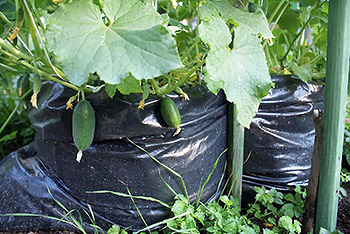 You may be interested in:
You may be interested in:After the seedlings have sprouted, you can plant in bags with soil under certain conditions:
- if the height of the seedlings has reached 25-30 cm;
- stem thickness 8-10 mm;
- the number of true leaves - 7-10 pcs.;
- the first flower brush formed.
For undersized varieties, the bag is filled by 40%, the rest is tucked, it will still be needed. First, in the planting ground, you need to make holes, 3-4 in each, and plant the seedlings as deep as possible so that the stem is stable, and the roots can grow.
Plant care
After planting, seedlings need to be watered twice a week with warm water at room temperature, in hot weather - it needs to be watered every other day. Each watering should be done only under the root, without falling onto the leaves to avoid diseases and be accompanied by loosening so that the crust does not form.
On the growing bushes already in the period of the tie begin to make support 2-3 weeks after transplantation. At the same time, stepsoning is also carried out - a cut of new shoots, if any, depending on the variety.
Advice:
- In order for pests not to get into the bags, they can be placed on pallets or on bricks.
- It is recommended to place the bags in the sun, this will provide additional nutrition with trace elements.
- In order to keep the crop constant, you can plant several different varieties that differ in ripening time.
- If you can’t often water it, you can install vermiculite, a resinous mineral that can absorb moisture and regulate the water balance in the soil.
- In case of frost, cold weather and rain, the remaining edges of the bag can be deployed and covered by hiding the plant.
- For the first time, months of growth need to be added to the ground so that the trunk of the bush stands stronger.
- If during cultivation the tomatoes had diseases, then at the next planting the bags should be disinfected in potassium permanganate.
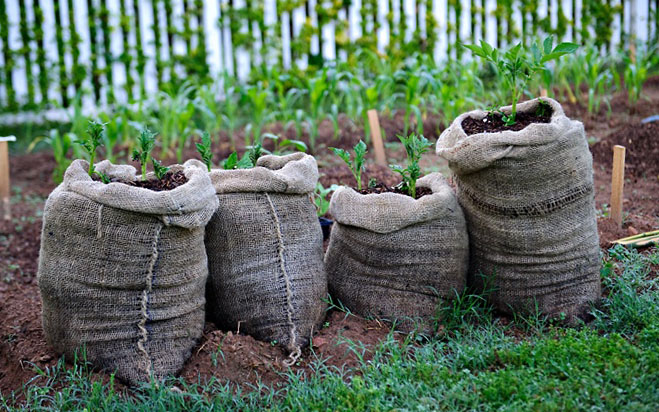 You may be interested in:
You may be interested in:Bag growing technology is not intrinsically complex. If you follow the rules, significantly reduced time for caring for plants. And the harvest will be richer and tastier.




 Low-growing tomatoes, without pinching: 5 of the most delicious varieties
Low-growing tomatoes, without pinching: 5 of the most delicious varieties Why tomato seedlings grow poorly
Why tomato seedlings grow poorly We grow a tomato in a shell
We grow a tomato in a shell Growing tomatoes without watering according to the method of Kazarin
Growing tomatoes without watering according to the method of Kazarin